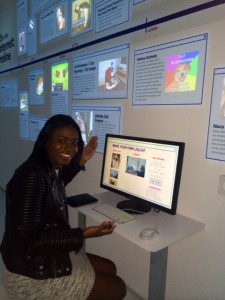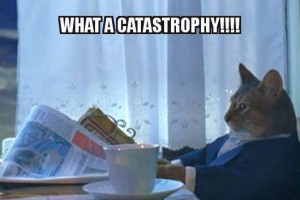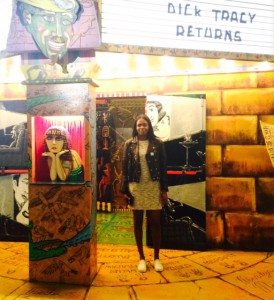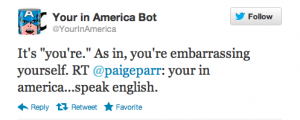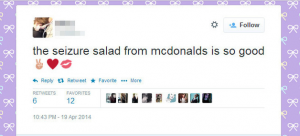The American Academy of Children & Adolescent Psychiatry expects the multiracial children population to be one of the fastest growing segments of the U.S. population. Individuals who identify as “raceless” and who have offspring are increasing the population and the likelihood of having more progressive children. Although the number of mixed-race-families are increasing, the label of whether a child is black or white will be tougher than ever. In my presentation I explore many popular offspring of blended families still face the struggles of what box to check.
Author Archives: jstephenson
Do Raceless Individuals Exist?
As many of you know or may not know, I was born in Jamaica— an island with an ancestry of both Taino and Africans. Before I migrated to America, I never labeled myself as black, non-white, non-hispanic because those terms did not exist in my vocabulary or culture– I was Jamaican and then I came here. For many immigrants there is a unwritten language that you have to know here without being directly told that the language even exist which is to categorize yourself. One of those subtle languages you are expected to know is the language and the history of race in America. Race in America is extremely sensitive, there is almost no way to desensitize the terrible implications of slavery.
First, I must say that as an outsider, it is unique paradigm to see, you are a part of it but in many ways your are not. There is the white world and the black world– no mater what country you are from you are forced to choose a category. I don’t make the rules, that just how it is in America. We are encouraged to create a three fold color scheme where white, black and shades of grey exist but the reality is the predispose and reinforced dichotomy only exist with two shades and the American media reinforces it every single second they have. And for any second you think that it does not exist then you are too naive or you have been privileged to have not seen the murky waters.
There are people who are forced to categorize, label or identify, whatever they are calling it now, as one or the other and then there are those who identify as raceless individuals. Not to discount their reasoning on identifying as a “raceless individual” because it’s quite a utopian view, however let me remind you that this is America we are talking about. You cannot afford to choose because the choosing has already been done for you, the choice has been made. In Lisa Lebduska article “Racist Visual Rhetoric and Images of Trayvon Martin” she toys with the idea “Whether we see, what we see, and how we see it is determined by tacit cultural conventions and regulations.” (1) The truth is or at least my truth is, you can’t change it because you can’t undo slavery, you can’t undo racial tension, the eyes can’t unsee it, you can’t rewrite the past and you can’t change the past. You can’t prevail in America as a raceless individual because it won’t allow you to, you have to choose black or white or by some chance you may be both but nonetheless you still have to choose. You are not afforded the luxury of not seeing color or any features that expose someones’ ancestry because the American conventional views does not allow it. The ways in which we see a person, and how we see them are influenced and will continue to be influenced by the traditional ways of thinking of the already established, non-changing paradigm of America.
So where do we go from here you may be asking and my answer is I don’t know.
The Virality of Memes
Memes inception is here to stay. Memes provide an opportunity to connect with people of all sort. To say that memes has not had any effect on popular culture is like saying global warming has had no effect on the world. Another added bonus of memes is that it encourages participation and shareability. Memes have the ability to be shared across a wide range of platforms and on smartphones as well which is major. Memes encourage collaborative community while also cultivating a new form of discourse community— they are unlike traditional culture.
The Effect of Memes on Popular Culture
Memes are one of the greatest accidental inventions of all time. By some miraculous chance, Internet users are able to search and find over a million different memes of various backgrounds. Being that I am a millennial, I am very familiar with memes and how much of a major impact it has on popular culture. In Chapter 4 Cohen and Kenny eloquently says “some memes enter our culture in the form of slang or knowledge, such as the terms “bae”, selfie, or fail, and some enter our mind as something culturally relevant and unforgettable” page 109. I found this to be extremely important because it is signifies how slang terms whether from online or while spoken, it somehow enters the ecosystem and we have to learn to incorporate it in each of our lives. No matter how old you are or wherever you are in the world, memes will touch your life.
Memes provide an opportunity to connect with people of all sort. To say that memes has not had any effect on popular culture is like saying global warming has had no effect on the world. Memes have become similar to emojis— you use it like anything else. Often times when I am texting my friend, we communicate by sending memes to one another to try and convey our emotions or just have a lost. Sometimes when I am texting the first thing that comes to mind is “OMG let me find a meme for that.” It is the easiest way for me to communicate. In happy moments, in sad moments, in moments of confusion, memes are the way for millennials to express themselves. Memes have absolutely affected every part of popular culture as well as our emotions. Sometimes when individuals see a meme they experience many different emotions such as joy, sadness, happiness, fear etc.
Another added bonus of memes is that it encourages participation and shareability. Memes have the ability to be shared across a wide range of platforms and on smartphones as well which is major. Memes encourage collaborative community while also cultivating a new form of discourse community— they are unlike traditional culture. It allows you to be part of a community and be able to contribute to the community. Many meme composers within the popular culture realm participate with memes on platforms such as weblogs, Twitter, Facebook, Snapchat just to name a few. These platforms allow a user to interact with their friends and loved ones using memes and incorporating other multimodal features. The composer has the ability to create, remix, repackage, redistribute the content. Being a part of the content generating community allows for individualism and the composer has given a voice. The community has many affordances and it can add to the digital ecosystem. With all good things comes the bad. Although you can create and redistribute the content you create, once it goes viral that’s it– you’ve have lost “ownership” of it, it becomes a product of the Internet.
There is no doubt that memes have had a significant impact on our culture, our ways of knowing, the emotional self, how we see the world and how we interact with it. It is extremely important for content composers, content consumers to keep in mid the effects of memes and new digital literacies and what effects it will have on the population.
The Museum and Me
Nestled in Astoria, Queens, the Museum of the Moving Image is unlike any museum I have ever been to. The museums brings together art, photography, film, digital media and technology seamlessly while incorporating moving images. At first glance you would miss the museum but you would be drawn to the unique mirrors doors adorned with pink. The “How Cats Took Over the Internet” exhibit was phenomenally curated. For any ailuromaniaes this is heaven. The exhibit explored how millions of images, videos of cats went viral over the past few years. The videos showed a different side of cats that changed my views on cats, I am not a cat lover. There was even a timeline to show the rise of cats on the Internet. I even got to make my own meme.
Me making a meme:
My meme:
On the second floor of the museum, I found collection of Star Wars, the Wizard of Oz, the Cosby show, Jim Carrey artifacts, just to name a few. This had a more traditional set up with artifacts in cases. There was even a Egyptian movie theatre!! I am so inspired to go to Egypt now!
In all it was catastic! I enjoyed being a part of this interesting discourse community. Exploring Moving with Images was one of the highlights of my Fall semester. I especially loved how they incorporate real-time flipbook for the visitors to leave a trace of themselves.
Class Notes 10/13/15
Dr. Reneta Lansiquot will stop by next Tuesday 10/20.
Post the response blog to the reading and to the museum visit.
Read:
- “Iconographic Tracking: A Digital Research Method for Visual Rhetoric and Circulation Studies” (Laurie E. Gries, Computers and Composition, December 2013): print, annotate, and bring to class
- “Picking Up the Fragments of the 2012 Election: Memes, Topoi, and Political Rhetoric” (Ben Wetherbee, Present Tense: A Journal of Rhetoric in Society, 2015): print, annotate, and bring to class
Definitions
Multimodality- describes communication practices in terms of the textual, aural, linguistic, spatial, and visual resources – or modes – used to compose messages.
Icon-a person or thing regarded as a representative symbol of something.
Iconography- the images or symbols related to something.
real-time-the actual time during which something takes place <the computer may partly analyze the data in real time
taxonomy-is the practice and science of classification.
folksonomy- is a system in which users apply public tags to online items, typically to aid them in re-finding those items.
Our class might be featured on the OpenLab Spotlight section
One person to present on one of the readings.
Twitter moments to keep in mind
timely vs. real-time
editing vs. presenting
accessibe
curated
recent news
surfaced content
hashtag
searchability
more than one dynamic with interactive
expansion of original literacy
Memes- take into account how means go viral and how to incorporate it into your meme creation.
There needs to be more dynamic to interacting with content not only liking a post.
**Keep in mind the strategy that are often times used in social media.**
LinkedIn: Can You Recommend Me?
LinkedIn: Can You Recommend Me?
LinkedIn is considered to be one of the most important platform for being an professional with over 1,000,000 active users. For many professionals who seek credibility often times ask past co-workers, mentors or professors for recommendations. Many users who have recommendations stand out to recruiters. It is very significant because professionals seek validation from past/current employers. Another community within the LinkedIn community is the group capability. Groups allow liked-minded professionals to join in on important discourse related to their fields or wherever their interests lie. In the presentation I pose the question do groups play a role in exclusion of certain users? But at the same time recommendations and groups play an essential role in how you represent yourself.
Prezzi
To my surprise, I found Prezi to be difficult. The presentation software same seemed easy when I first set up the account even the introductory how it works presentation to be exhausting. It was very interesting trying out Prezi for the first time. I had no idea idea what template to choose so I chose the most basic one. While using the basis template of Prezi, it still went over my head. For one thing, the zoom feature is my least favorite, it goes up and down and I’m still getting used to the set up of the software. In a way, I can understand the popularity with Prezi, it does allow certain features that Powerpoint does not like the movability of it, the cool storytelling of it, redirecting of the arrows. I say this not to discount Powerpoint because of its simplistic, organic features. Most traditional businesses tend to use Powerpoint, I think several start-up companies would love Prezi.
It was a great experience to try a new software— pretty cool! I’d be very impressed if someone takes the capabilities of Powerpoint and Prezi and create a super presentation software but in the mean time I’ll stick to Powerpoint for now.
Are Social Media Sites an Extension of Who We Are?
Marshall McLuhan famously said “the medium is any extension of ourselves,” which brings me to ask, are social media sites an extension of who we are or is it a fabricated persona of who we want to be perceived as through a mediated medium?
Social Media’s Effects on Writing and Language
How do I even begin to define language? Dictionary.com describes language as a body of words and the systems for their use common to a people who are of the same community or nation, the same geographical area, or the same cultural tradition. But I believe language to be more than that. I think it can be viewed as a journey in connecting people, things and giving them an chance to co-exist. As I look to dictionary.com to define writing, I realize there is no true words that can define writing or what has been written or the act of writing. The one word that comes close to writing seems to be magic. Writing is magic because its an art of producing art, despite how mundane that may sound. It’s magic and beauty in the purest of sense.
In Chapter 8 of the Carroll textbook (pg. 253) he says “Both Twitter and the telegraph have been blamed for erosion of language. Email, texting, Facebooking, and chat, too, are likely having a corrosive effect on language.” I was surprised by the bold claim Carroll made about the effects social media has had on writing. When I look further into it, Carroll does have a point. Most of us are participating in emailing, texting, facebooking, tweeting, sharing, instagraming, snapchatting, blogging, and the other mediums and each require the user to be knowledgeable in that space. In addition to the users being knowledgable on how to communicate in these spaces, the way in which they communicate in the space is extremely important. The way in which a composer speaks on a blog or sends a tweet or a Facebook post is entirely different. Sites like Twitter, limit the user to 140 characters to convey his or her thoughts. For this purpose the user must use language that pertains to that audience and the space. By using these many medium they all play a role in our language. Our communication styles on these platforms significantly affect how we write. Some of these habits make their way into our professional careers or school work. Social media is giving new meaning to writing whether or not we see it as a affordance or a constraint. Even the dictionary has changed. Words like seflie, bruh, fleek, awesomesauce, manspreading, etc. has someway made it into the dictionary. It is absolutely no doubt the impact of social media and generating new words will have on the way in which we digest information.
Like all things, discourse as we know it, language as we know it, is being redefined by social media. This new development in social media has given new meaning to words such as friend, like, tweet, hashtag. These words are more actionable than before which creates new meaning and new communities. This impressive online community and the way in which they communicate in a short 140 character can have a detrimental effect on language. Many of the our short/crafted responses are limited to characters which leaves many of room for grammatical error for example:
http://cdn2.mommyish.com/wp-content/uploads/2013/07/Screen-Shot-2013-07-07-at-10.44.12-AM.png
https://unionmetrics.s3.amazonaws.com/tr_blog/2012/11/Your-in-America-Bot1.png
http://giveitlove.com/wp-content/uploads/Awesome-Twitter-Grammar.png
The beautiful art of writing and language is suffering due to social media and it’s up to us to be the guardians of our art.
The Drum: How Brands Can Participate in the Future of TV
Last Tuesday I had the honor of being invited by The Drum’s CEO, Gordon Young, to their seminar “How Brands Can Participate in the Future of TV” The UK based media house recently marked its territory in New York which proved it to be a force to be reckoned with. The Drum is a creative agency that provides first class news information on marketing across an array of communication fields including Public Relations, Social Media, Advertising just to name a few. The seminar was a thoughtful discussion about the advertising discourse community and how brands can participate within the ecosystem. The panel discussion brought together Jim Mollica, the Vice President of Digital Under Armour, Jessica Sheehan, VP and Head of Social Media for JPMorgan Chase, Chad Parizman, Director of Convergent Media at Scripps Networks Interactive and Marc DebEvoise, Executive Vice President and General Manager of CBS Digital Media. As a first time attendee, I found the discussion to be surprisingly insightful.
I was so grateful to have had the opportunity to join the conversation of how TV Networks, new technologies, social media are reshaping brands relevancy in the digital age. Many brands who lack creativity and who do not adapt to the new expectations will become dinosaurs, and we are all too aware of what happened to dinosaurs (they’re dead)–spoiler alert! As a composer of content, I realize how imperative it is to be creative, resourceful, tech savvy, to be able to create a holistic experience for the readers/consumers of digital media. People are consuming content differently, whether its through different mediums or mediated outlets such as smartphones or tablets. The way we digest information is changing and will continue to change and it is up to the writers to be well versed or risk being inept. Writers and marketers have to tap into the mobile audience and provide insight, catchy content that will be unique to the readers. When new technologies are created there are new communities that are created and deliver a new approach for those communities. With the affordances of new communities, it creates a change in how we package our content, how the consumer receives it, and how they participate in that discourse community.
In essence, the role of the composer in these digital spaces is extremely difficult. For the composer to be a part of the community, shaping the community, creating new experiences within the community is extremely challenging. The magnitude of the impact composers will have on their readers/consumers is one we all know too well and they have to wear many hats. . . So as a composer, please excuse me as I learn what other hat I need o wear.

